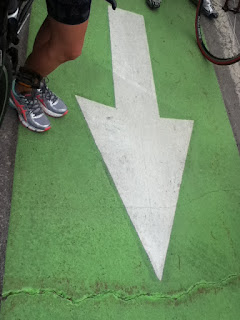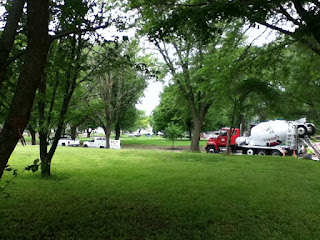 |
| Many of the riders gathered in front of The Hotel at Kirkwood |
Corridor MPO, the county-wide organization charged with coordinating transportation initiatives, touted a number of bicycle-related projects Saturday on the second annual MPO Bike Ride. Multi-modal transportation planner Brandon Whyte led the tour of sites including protected bike lanes in Cedar Rapids, a trail extension from Ely into rural Linn County, and a proposed trail bridge across the Cedar River.
Besides the protected lanes to be installed on 3rd Avenue this summer, Whyte also demonstrated the green striping of bike lanes downtown. These are being added near intersections to show where the lanes start and to distinguish them from auto traffic lanes. The city has experimented with two types of paint, MMX (pictured above) and thermoplastic (below).
The thermoplastic costs about twice as much, but is brighter and considerably more durable, so would not only pay for itself but also be more serviceable. The paint is funded by a grant from Linn County Public Health.
Across the river, the MPO is working on a connection between the Cedar River Trail (which runs along a bluff at this point) and the park area being developed by the City of Cedar Rapids in Czech Village.
...and continue along streets to Bowling Street, ultimately connecting the Cedar River Trail with the cycle track that runs alongside Bowling beginning at Wilson Avenue. The cycle track itself is in hope of an upgrade, and most of the riders eventually retreated to the street. There are about 30 curb cuts on Bowling between Wilson and Miller Avenues--I lost count--and a potentially dangerous water main, but the real problem is the interfacing (or lack thereof) between track and the driveways, which makes for a bumpy ride. I didn't get a really good example when I finally stopped for a picture: the interfacing at this driveway is smooth enough, but the patches are rather treacherous anyhow.
Brandon suggested they might look into bike lanes on Bowling Street to supplement or replace the cycle track. The cycle track ends at Miller; we proceeded to Kirkwood Community College for a tour of the hotel and Kirkwood Center for Hospitality Arts...
...and then rejoined the Cedar River Trail on Wright Brothers Boulevard. Around Kirkwood and in rural Linn County the biking is rather iffy away from the trail: narrow highways and fast cars mean bicycles mix awkwardly. Fortunately, at least on Saturday morning, traffic was light and there were only one or two mildly awkward encounters.
The ride continued as far as Ely, 11 miles southeast of New Bohemia, where we stopped at the community center located in the re-purposed Ely School.
Ely School was built in 1923, held classes until 1969, and was converted to a community center in 1973.
Only the exterior is from the 1920s; the interior was entirely re-done in the 1970s.
In the council's conference room, Ely Mayor Jim Doyle announced the town's support for extending the trail from Ely City Park (where it currently terminates) through and out of Ely south to the county line (Seven Sisters Road). When the other counties complete their parts the Hoover Nature Trail will go all the way to Burlington! Ely is currently deciding among a number of possible routes through town:
An MPO representative from Marion described efforts in that city to complete its portion of the CEMAR trail, as well as repair or replace railroad bridges over Marion Boulevard and Indian Creek; and John Wauer talked up the Linn County Trails Association (of which your humble blogger is a member).
We had a refreshment stop at Odie's Bar and Grill on Dows Street (blocked off for a street dance scheduled that evening). Some of us interpreted this as lunchtime, and I'm glad I did: The tenderloin sandwich was timely and delicious, and the restrooms were nicer than the ones at my house. For the record, those familiar with Ely also commended the coffee at The Retreat. So trail riders are sure to be well-taken-care-of.
It was trail all the way back to Cedar Rapids, an easy glide but for the horizontal spitting rain that seems to appear whenever Brandon Whyte plans an event. (Ha ha--Just checking to see if he's reading this!) There was one more thing to see: Steve Sovern of the South Side Investment Board stopped at the site of a railroad bridge known as the "Sleeping Giant" that was destroyed in the 2008 flood, and which advocates are hoping to turn into a pedestrian-and-bike path for a different entrance to New Bohemia, or a loop for people coming from the north.
It would intersect the Cedar River trail as it goes by the landfill (which local officials prefer to call "Site A," but which Sovern prefers to call "Mt. Trashmore"). The cost of the bridge would run to $3-4 million, so Sovern and his associates are working with the Iowa Natural Heritage Foundation on grant writing.
The projects discussed along the way were a mix of recreational and commuter uses, which is a fair reflection of the future of biking in America. The MPO webpage offers the information, courtesy of the National Complete Streets Coalition, that 52 percent of Americans want to bicycle more, and that most of them cite the condition of the streets as at least one reason why they don't. Projects like protected bike lanes downtown, bike lanes on high-traffic routes, and trails help serve that portion of the public. (They serve the non-biking public, too, whether they're aware of it or not, but that's a subject for another day.)
SEE ALSO Linn County road map, for those of you following along at home
 |
| Brandon Whyte pauses on 3rd St SE to discuss green paint |
The thermoplastic costs about twice as much, but is brighter and considerably more durable, so would not only pay for itself but also be more serviceable. The paint is funded by a grant from Linn County Public Health.
Across the river, the MPO is working on a connection between the Cedar River Trail (which runs along a bluff at this point) and the park area being developed by the City of Cedar Rapids in Czech Village.
The connector would come down from the trail as pictured above at about 21st Avenue SW...
...and continue along streets to Bowling Street, ultimately connecting the Cedar River Trail with the cycle track that runs alongside Bowling beginning at Wilson Avenue. The cycle track itself is in hope of an upgrade, and most of the riders eventually retreated to the street. There are about 30 curb cuts on Bowling between Wilson and Miller Avenues--I lost count--and a potentially dangerous water main, but the real problem is the interfacing (or lack thereof) between track and the driveways, which makes for a bumpy ride. I didn't get a really good example when I finally stopped for a picture: the interfacing at this driveway is smooth enough, but the patches are rather treacherous anyhow.
Brandon suggested they might look into bike lanes on Bowling Street to supplement or replace the cycle track. The cycle track ends at Miller; we proceeded to Kirkwood Community College for a tour of the hotel and Kirkwood Center for Hospitality Arts...
 |
| Brian Schooley, Front Office Manager |
The ride continued as far as Ely, 11 miles southeast of New Bohemia, where we stopped at the community center located in the re-purposed Ely School.
Ely School was built in 1923, held classes until 1969, and was converted to a community center in 1973.
Only the exterior is from the 1920s; the interior was entirely re-done in the 1970s.
In the council's conference room, Ely Mayor Jim Doyle announced the town's support for extending the trail from Ely City Park (where it currently terminates) through and out of Ely south to the county line (Seven Sisters Road). When the other counties complete their parts the Hoover Nature Trail will go all the way to Burlington! Ely is currently deciding among a number of possible routes through town:
An MPO representative from Marion described efforts in that city to complete its portion of the CEMAR trail, as well as repair or replace railroad bridges over Marion Boulevard and Indian Creek; and John Wauer talked up the Linn County Trails Association (of which your humble blogger is a member).
We had a refreshment stop at Odie's Bar and Grill on Dows Street (blocked off for a street dance scheduled that evening). Some of us interpreted this as lunchtime, and I'm glad I did: The tenderloin sandwich was timely and delicious, and the restrooms were nicer than the ones at my house. For the record, those familiar with Ely also commended the coffee at The Retreat. So trail riders are sure to be well-taken-care-of.
It was trail all the way back to Cedar Rapids, an easy glide but for the horizontal spitting rain that seems to appear whenever Brandon Whyte plans an event. (Ha ha--Just checking to see if he's reading this!) There was one more thing to see: Steve Sovern of the South Side Investment Board stopped at the site of a railroad bridge known as the "Sleeping Giant" that was destroyed in the 2008 flood, and which advocates are hoping to turn into a pedestrian-and-bike path for a different entrance to New Bohemia, or a loop for people coming from the north.
It would intersect the Cedar River trail as it goes by the landfill (which local officials prefer to call "Site A," but which Sovern prefers to call "Mt. Trashmore"). The cost of the bridge would run to $3-4 million, so Sovern and his associates are working with the Iowa Natural Heritage Foundation on grant writing.
 |
| Steve Sovern (center) answers a question about the Sleeping Giant project |












No comments:
Post a Comment